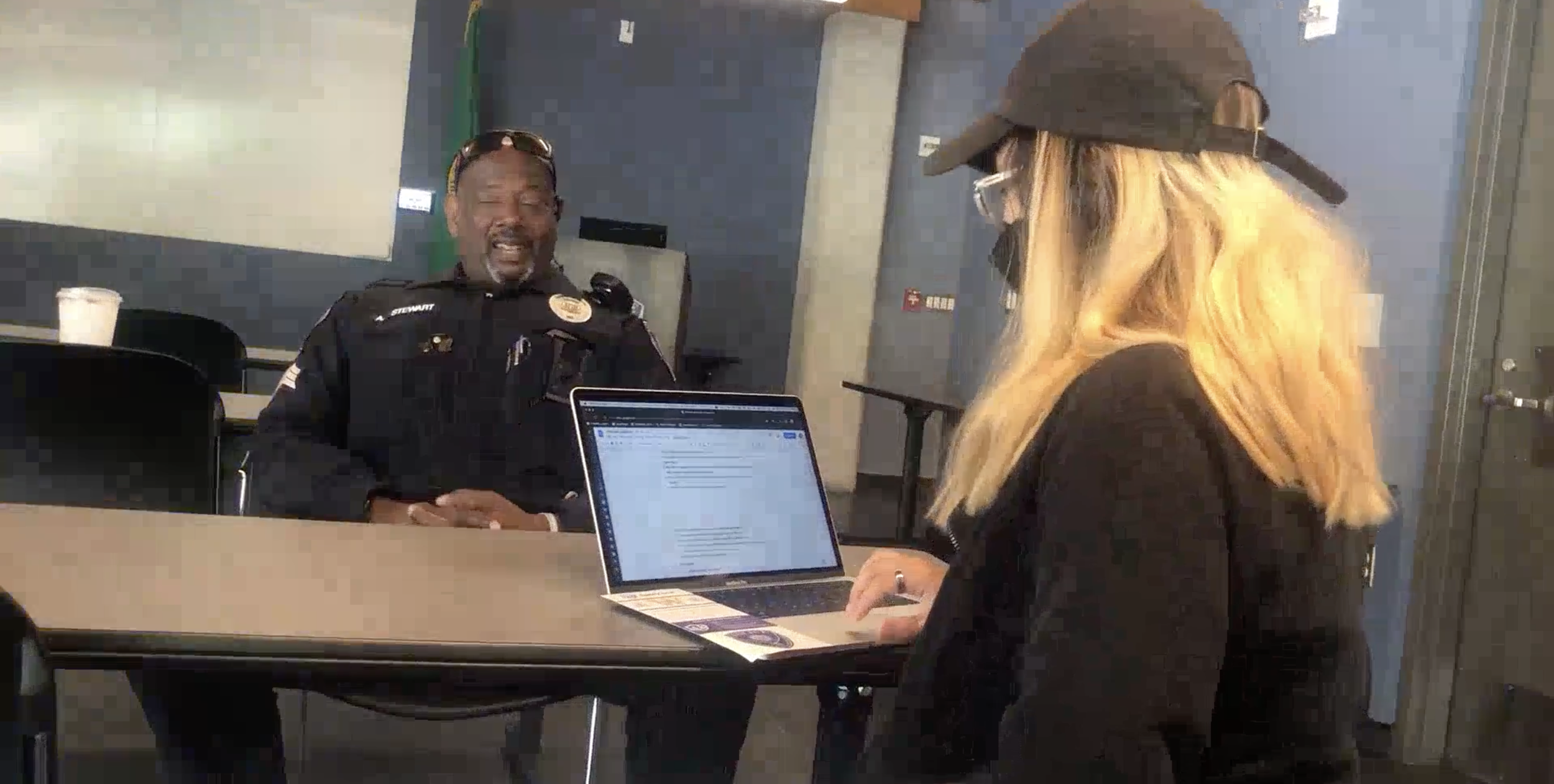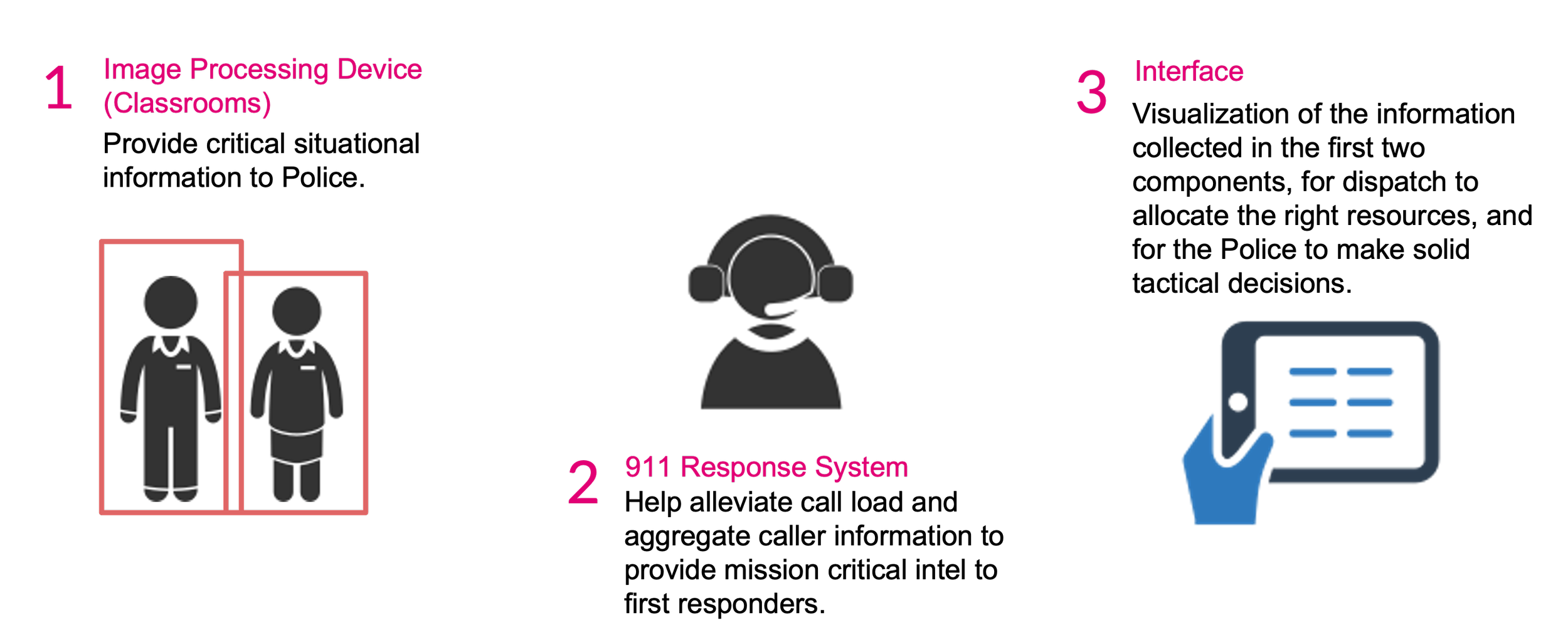PROMPT FROM
“How can we help First Responders during emergency situations?”
Role:
Conducted Literature Research, Interviews, Contextual Inquiries, User Journey Mapping, Ideation, Concept and Usability Testing.
Team:
Vinitha Erusu (UX Research & Design)
Yuqing Zhang (UX Design)
Yiwei Wu (UI Development & UX Design)
Chuan-Li Chang (Development)
Garrett Millaway (Project Management)
Duration:
6 months
June 2022- December 2022
Project Details:
Industry-led Capstone Project
University of Washington (MS in Technology Innovation)
Project Sponsors: T-Mobile
WE STARTED BY ASKING WHY THIS WAS IMPORTANT TO T-MOBILE
To demonstrate the capability of 5G…
to solve social problems that are especially time sensitive like emergency response…
by making use of next gen technology that require high speeds and processing.
WITH THE PROMPT BEING BROAD, WE TOOK THEIR RESPONSE AS A GUIDE TO SCOPE DOWN
UNDERSTANDING HOW WE CAN HELP FIRST RESPONDERS:
How do First Responders respond to emergency situations?
What problems do first responders face during their response?
DIRECTIONS THAT DID AND DID NOT SHOW PROMISE:
INDIVIDUAL CASUALTY INCIDENTS The response provided is different based on casualty condition and type of incident making it difficult to identify viable problem areas to address.
MASS CASUALTY INCIDENTS: Ineffective coordination and communication between different organizations severely impacted the first response.
TWO POSSIBLE METHODS TO FURTHER SCOPE:
INTERVIEW SMEs who also have experience in designing technologies for this area, to identify promising directions. The lack of resources made it difficult to take up this task.
Identify and impose constraints to help scope down from the following different types of mass-casualty incidents-
NATURAL DISASTERS - MASS SHOOTINGS - TRANSPORTATION DISASTERS
BRAINSTORMING WITH CONSTRAINTS:
IMPOSED- Consider the potential 5G technology solutions.
IDENTIFIED- Consider the viability of carrying out the different project stages.
IMPOSED- Identify the opportunties provided by the different possible directions.
Chosen Direction- SCHOOL SHOOTINGS IN THE USA
CHOSEN PROBLEM SPACE
SCHOOL SHOOTINGS IN THE USA
School shootings reached an unprecedented high in the academic year of 2021-2022 with 193 school shootings.
Reports suggest “systemic failures and poor decision-making" leading to poor response during these incidents.
WE WENT ON TO LEARN THE PREVENTION AND RESPONSE CARRIED OUT FOR ACTIVE SHOOTING INCIDENTS
911 Call Center (PSAP)
Police Departments
Fire Departments
Schools
LITERATURE RESEARCH (20+ arts.):
To get a comprehensive understanding of the problem space and identify the problems faced while responding.
INTERVIEWS (15+ with Police, Fire, 911 Call centers, EMTs, Universities, Public and Private Schools, and the T-Mobile Emergency Management Team):
Verify and probe further into the identified problems faced during the response, and understand existing solutions and measures taken towards this problem.
CONTEXTUAL INQUIRIES (5+ with Fire, 911 Call Center, and Schools and University Departments):
To understand the response process in detail.
UNDERSTANDING THE RESPONSE PROCESS HELPED IDENTIFY THAT THE 911 CALL CENTER AND THE POLICE ARE CRITICAL IN DETERMINING THE OUTCOME
GETTING A COMPREHENSIVE UNDERSTANDING OF THE PROBLEM SPACE HELPED IDENTIFY THE 3 ESSENTIAL PROBLEMS FIRST RESPONDERS FACED
Police find difficulty in determining if the shooter in the school is barricaded (i.e. alone) or actively shooting (i.e. in the presence of other victims)
Police find it difficult to know the number and location of shooters and victims.
Police find it difficult to communicate effectively to establish incident command and carry out a coordinated response across multiple organizations.
AND ALSO IDENTIFY THE 2 CRUCIAL BARRIERS TO RESOLVING THESE PROBLEMS
PRIVACY BARRIER:
Schools did not allow cameras in classrooms in the interest of protecting the privacy of the teachers and students.
DEPARTMENTAL INTEROPERABILTIY BARRIER:
With issues in effective radio communication, and with different departments (Police, Fire, Medical, and Schools) and departments of different cities having different response protocols and tools used, it became difficult for the responderes to effectively communicate to carry out a coordinated response.
TO ADDRESS THESE NEEDS WE PROPOSED A 3 COMPONENT SOLUTION
Our solution targeted to primarily aid the 911 call centers and the Police as they were the most critical responders.
TO SCOPE DOWN, WE WENT AHEAD WITH DESIGNING FOR THE IMAGE PROCESSING DEVICE AND THE INTERFACE THAT PRIMARILY AIDED THE POLICE
WE DETAILED HOW OUR SOLUTION WOULD ADDRESS THE BARRIERS TO PRIVACY AND DEPARTMENTAL INTEROPERABILITY
Our interface would be a third party web application that officers could access through their existing Computer Aideded Dispatch (CAD) response software to be able to get a visualization of real situational time information of the incident and be able to communicate critical information within and across teams.
Our image processing devicew would only count and provide location of victims and shooters, and would not record any identifiable information that would infringe the privacy of the people.
DETAILING HOW OUR SOLUTION FITS INTO THE RESPONSE PROCESS POLICE CARRY WAS CRUCIAL TO BUILDING THE FLOW AND HIERARCHY OF INFORMATION PRESENTED IN THE INTERFACE TO THE FIRST RESPONDERS
FIRST PROTOTYPE ITERATION
Camera and a Raspberry Pi 4 board for People detection and counting as part of the classroom device.
Our interface provides an area map visualization of the school locations alerting the Police about the schools that are experiencing an active shooter situation.
The Police can then open up a visualization of the schools in the form of floor plans that provide critical situational information that the Police require to respond.
TESTING THE CONCEPT AND USABILITY WITH FIRST RESPONDERS
RESEARCH QUESTIONS:
PARTICIPANTS:
We tested with 6 police officers at Bellevue City Hall.
1 Police Captain
1 Patrol Officer
4 Members of Bellevue SWAT -
1 SWAT Team Lead, 1 SWAT Sergeant, 2 SWAT Team Members
USERS AND TASKS:
SCENARIOS:
KEY FINDINGS
Users had a difficult time knowing how to select the room they wished to change the "Zone" of and they had trouble precisely clicking the zone options due to the small size of the zone labels.
DESIGN CHANGE: Add the ability for users to select rooms from the map and the room list on the left side of the interface. Increase the zone control button sizes and include text to make it easier to quickly recognize the controls.Users had a difficult time interacting with the interface maps due to lack of touch/gesture controls.
DESIGN CHANGE: Add standard gestures controls to easily pan around the map and use pinch/spread gestures to zoom in and out.Users had a hard time determining if the Incident Command System had been established or if an officer had filled the Incident Command role.
DESIGN CHANGE: Add an icon that the IC can place on the map to clearly indicate where the IC post os located. Language used for the features must be improved to clearly indicate IC status.While the map provided basic information to respond to the situation, it lacked detail needed to make tactical decisions.
DESIGN CHANGE: Add door locations as well as their path of opening. Add window locations. Add emergency exits (Fire ladders).Users notice the ‘video’ icon we placed on the interface and repeatedly tried to acess the page.
DESIGN CHANGE: All users when asked showed high interest in the feature. Add video icons to each room with the device active. Allow officers to stream video data directly from the in room device.
ONGOING INTERVIEWS WITH SCHOOLS HELPED FIND INSIGHTS TO ADDRESS BARRIERS OF PRIVACY AND COMMUNICATION
KEY FINDINGS:
It is important that our solution integrates with the existing PA and lockdown systems in schools.
Schools were more willing to overlook privacy if the video feed is not being stored and also when an active shooting incident is occurring.
Schools were willing to work with law enforcement to provide information that the police needed during a shooting incident.
The solution should help first responders easily decide how to enter the building, such as know entry acess points and their provided smart lock systems, as well as know locations of fire doors and escapes.
SECOND PROTOTYPE ITERATION
Camera and a Raspberry Pi 4 board for People detection and counting, a battery for backup power supply and LED for visual indication of when the device is "ON", as part of the classroom device.
Improved working web-based interface prototype with improved Incident Command features, detailed floor plan visualization, and improved interactivity for ease of use.
TESTING THE USABILITY OF THE IMPROVED INTERFACE WITH FIRST RESPONDERS
Research Questions:
Participants:
We conducted usability testing with-
2 Police officers at Bellevue City Hall -
Bellevue Police Captain, Bellevue Police Detective
3 Firefighters from the Bellevue FireDepartment.
Bellevue Fire Battalion Chief, Bellevue Fire Captain, Bellevue Fire Lieutenant
KEY FINDINGS
FINAL PROTOTYPE ITERATION
Camera and a Raspberry Pi 4 board for People detection and counting, a battery for backup power supply, RGB LED for visual indication of when the device is "ON", 5G RPI hat for 5G connectivity, and a button (used by teachers) to activate the device/lockdown, as part of the classroom device.
Improved interface with floor plan and surrounding details, applied default zoning settings and with the video feed feature for all classrooms.








































